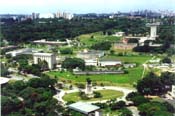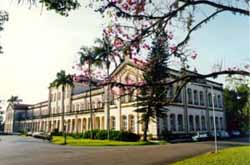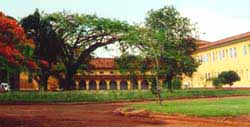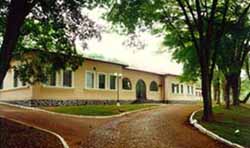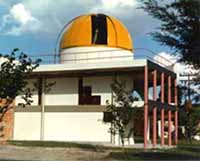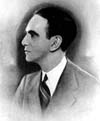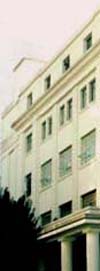| Presentation |
| Organizing Committee |
| Program Committee |
| Program |
| Tutorials |
| Workshops |
| Registration Fees |
| Registration |
| Hotel /Air ticket Reservations / City Tours |
| LADC Links |
| About São Paulo |
| University of São Paulo |
| Polytechnic School |
| | |
|
|
||||||||
The University
of São Paulo (commonly referred to as USP) is the largest
institution of higher education and research in Brazil, and
the third in size in Latin America. It is also classified among
the largest one hundred of the approximately six thousand such
organizations in existence in the world today. USP is influential
in the area of higher education in the South-American continent,
having educated countless professors with masters' and doctors'
degrees now teaching at private colleges and universities in
Brazil. With its numerous accomplishments throughout the years,
USP continues to evolve in the areas of education, science,
technology, and the arts.
USP was founded with the purpose of fostering research, advancing science, and transmitting the knowledge that enlivens and develops the human spirit and promotes human life. The university aims at the preparation of specialists in all fields of culture and in all scientific and artistic professions, its motto being: "You shall conquer through knowledge." Its objectives include providing the students with a dynamic education which will enable them to keep pace with the transformations in knowledge and maintain permanent dialogue with society in a productive integration that joins education, research and university extension. USP's teaching units are distributed among its six campuses: one in the City of São Paulo and five in the interior of the state, in the cities of Bauru, Piracicaba, Pirassununga, Ribeir�o Preto and S�o Carlos. The university's administrative infrastructure and 23 of its 35 teaching units are located on the campus in São Paulo, which bears the name of Armando de Salles Oliveira University City. Four other large schools are located off the campus and there are scientific bases and museums in a number of other locations, including Anhembi, Anhumas, Araraquara, Cananéia, Itatinga, Itirapina, Piraju, Salesópolis, São Sebastião, Ubatuba and Valinhos, in the State of São Paulo, and Marabá, in the state of Pará.
The university
offers undergraduate courses in all areas of knowledge, and ten
of its 23 national graduate programs were given the maximum grade
attributed by the Higher Education Coordinating Office (Capes)
of the Federal Ministry of Education.
To provide support
to its research activities, USP has units that are dedicated to
elementary and secondary education, including the Application
School associated with the School of Education, and the Technical-professional
Dramatic Arts School, of the School of Communications and Arts.
Through its extension
activities, such as the Neighbor Project (Projeto Avizinhar),
the Community Cooperatives, and the
Open University Project for Senior Citizens, USP plays a major
role in the growth of the communities near its campus. In addition,
its 24 museums and the Practical Science Museum (Estação
Ciência) jointly receive one million visitors per year,
including excursions made by approximately two thousand schools.
The university hospitals in São Paulo and other cities
in the state serve over one million persons. Besides these services,
the university has a Sports Center, called (Cepeusp),
jogging tracks, and excellent psychotherapeutic, genetic and dental
services, as well as a clinical analysis service. It also has
a university hospital (Hospital
Universitário), a veterinary hospital, and partnerships
with the General Hospital of the Medical School (Hospital
das Cl�nicas) and with the São Paulo Institute of Social
Medicine and Criminology.
With the purpose
of maintaining positive communication with its internal community
and with the public in general, all of the university's official
media are subordinated to the (CCS).
These media include the University Radio Station (Radio
USP), the University Television Channel (TV
USP), the USP
Press Agency, the USP
Magazine, the USP
Newspaper, the USP
Web Portal and the Espa�o
Aberto magazine.
A little history
In 1949, the School
of Philosophy, Sciences and Letters was installed in its sophisticated
building on Rua Maria Antônia, in Vila Buarque, near Mackenzie
College, and not far from the School of Architecture, the School
of Economics, the School of Sociology and Politics, and the Armando
Álvares Penteado Foundation.
The presence of students in the residential neighborhood of Vila
Buarque meant a great enthusiasm in the region, which soon became
the most important center of student activities in São
Paulo, almost a university campus in the heart of the city. In the context
of the worldwide unrest of 1968 - especially the student revolt
in France, the students' demonstrations at the University of California
at Berkeley, the Prague Springtime, and the Black Civil Rights
Movement in the United States - Brazil also participated in the
climate of dissension, with its own specific characteristics.
The Maria
Ant�nia Faculty of Philosophy actively participated in the
political and cultural atmosphere of the period. The street was
a meeting point for students, where all stood up as members of
the vanguard of critical thinking and took positions in regard
to the social, political and cultural conditions of the time.
It was a period of student marches, assemblies, manifestations
and demands, and it all came to a tragic halt with the burning
of the building on Rua Maria Antônia on October 2 and 3,
1968. The abuses of authoritarianism seriously affected the university in general. Many of its professors, as well as of other institutions of education and research in Brazil, were removed from their teaching positions, frustrating the progressive aspirations of the great majority of students and teachers. But USP survived the period and through the years other units, research institutions and museums were gradually incorporated into the university, multiplying and diversifying the courses offered. Today, as ever, the University of São Paulo strives to be a vigorous and dynamic institution, in constant growth and renovation with the arrival of new generations of students and teachers. However, in these almost seven decades of existence, it has already reached sufficient maturity to prepare a solid path for the future. |
